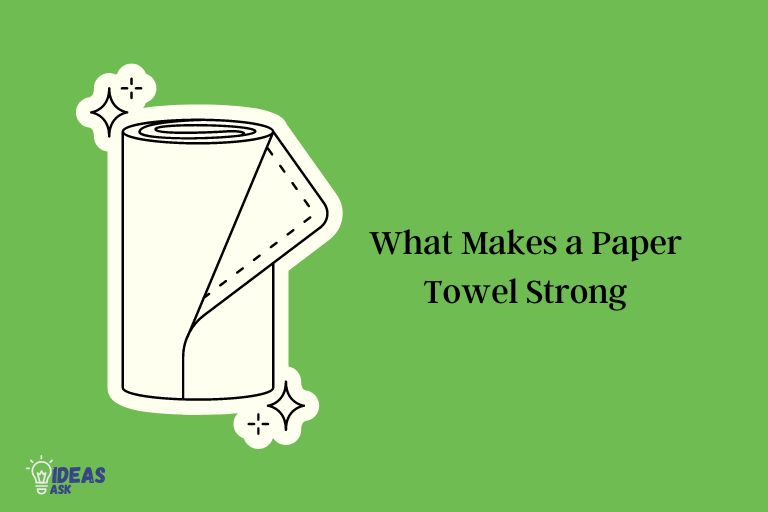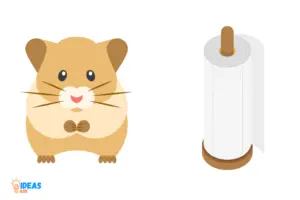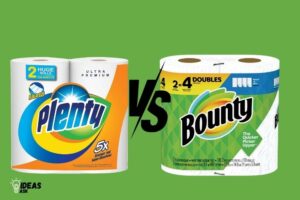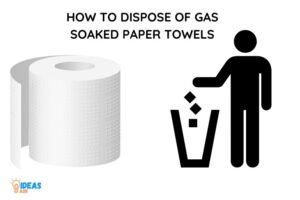What Makes a Paper Towel Strong? 7 Common Factors!
A paper towel’s strength comes from its material composition, manufacturing process, and multi-ply layers that contribute to its overall durability and absorbency.
Paper towels are made from cellulose fibers, which are derived from wood pulp or other plant materials.
These fibers are intertwined and combined with a binding agent during the manufacturing process, resulting in a strong, absorbent, and flexible sheet.
Key factors that contribute to a paper towel’s strength include the type and quality of the fibers used, the density of the fibers, and the presence of multi-ply layers.
A paper towel’s strength is crucial for its functionality, as it needs to withstand scrubbing and hold up when wet.
The use of high-quality cellulose fibers and a strong binding agent during the manufacturing process ensures a durable and absorbent product.
Additionally, the presence of multi-ply layers further enhances the towel’s durability, making it less prone to tearing and more capable of tackling tough cleaning tasks.
7 Common Factors that Affecting the Strength of Paper Towels
| Factors | Description |
|---|---|
| Raw Material | Paper towels are generally made from wood pulp. The quality of the raw material has a substantial impact on the strength of the paper towel. |
| Manufacturing Process | The way the paper towel is produced also affects its strength. This includes how the wood pulp is refined, the type and amount of adhesive used, and even how the towel is embossed. |
| Fiber Length | Paper towels made from long fiber pulps tend to be stronger than those made from short fiber pulps. |
| Plied Vs Single-Ply | Plied paper towels, which contain two or more layers, are typically stronger than single-ply towels. |
| Wet Strength Additives | These are chemicals added to paper towels to resist tearing when wet. More wet strength additives typically mean a stronger towel. |
| Drying Methods | The methods used to dry the paper towel during production can also influence its strength. Air drying, for instance, tend to produce stronger towels than heat drying. |
| Bleaching Process | A more extensive bleaching process can weaken the paper towel, making it less sturdy. |
Key Takeaway

Five Facts About the Strength of Paper Towels
How The Composition Of Paper Towels Affects Their Strength
The Significance Of The Cellulose Fibers In Paper Towel Strength
The composition of paper towels affects their strength significantly. Cellulose fibers are the primary component, and their arrangement determines the paper towel’s tensile strength.
These fibers intertwine, creating networks that withstand pressure and stretching. The higher the number of cellulose fibers, the stronger the paper towel.
• The strength of cellulose fibers in paper towels varies; one can find soft, hard, and rough paper towels.
• Hard, rough paper towels use long and tightly compacted cellulose fibers to derive their strength.
• Soft and highly absorbent paper towels make use of shorter and loosely compacted cellulose fibers.
How Manufacturers Use Synthetic Fibers To Enhance Paper Towel Strength
Paper towel companies use synthetic fibers, such as polyester or nylon, to increase their durability. These synthetic fibers intermingle effectively with cellulose fibers to strengthen the paper towels.
• High-quality paper towel brands use stronger and more elastic synthetic fibers for better results.
• The proportion of synthetic fibers in the paper towel affects its strength.
• Manufacturers mix synthetic fibers with cellulose fibers to enhance absorbency and strength.
The Impact Of The Paper Towel’S Density And Basis Weight On Its Strength
The density and basis weight of a paper towel influence its strength significantly. Density refers to the arrangement of cellulose fibers in the paper towel, while basis weight refers to the weight of a single sheet.
• A denser paper towel is usually stronger than a less dense one.
• The higher the basis weight of a paper towel, the stronger it is.
• Manufacturers balance between the density and basis weight to ensure they meet the desired strength and absorbency levels.
• Higher basis weight sometimes causes lower absorbency, leading to a less effective paper towel.
A paper towel’s strength depends on various factors like cellulose fibers, synthetic fibers, basis weight, and density. Manufacturers balance these factors to derive different types of paper towels to meet user needs.
Investigating The Role Of Absorbency In Paper Towel Strength
What makes a paper towel strong: investigating the role of absorbency in paper towel strength
When it comes to household essentials, paper towels rank high in the list of must-haves. They come in handy for wiping spills, cleaning surfaces, and drying hands.
But have you ever wondered what makes a paper towel strong? In this section, we’ll investigate the role of absorbency in paper towel strength.
How Highly Absorbent Paper Towels Can Still Be Strong
As the name suggests, absorbency is a paper towel’s ability to absorb liquids. It’s easy to assume that paper towels with high absorbency would be weaker compared to those with low levels.
However, this is not always the case. The trick is in the paper towel’s composition.
Here are a few reasons why highly-absorbent paper towels can still be strong:
- Multiple layers: High-quality paper towels often have multiple layers, making them thicker and sturdier than single-ply paper towels.
- Fiber quality: Paper towels made from high-quality fibers, like hemp or cotton, can absorb more liquid without breaking apart.
- Bonding agents: The glue-like chemicals used to hold the paper fibers together also play a part in a paper towel’s strength. Strong bonding agents help to hold the fibers in place even when they’re wet.
The Importance Of Paper Towel Thickness In Relation To Absorbency And Strength
A paper towel’s thickness determines its absorbency and strength to a large extent. Thick paper towels tend to be more absorbent and stronger than thin ones.
The reason for this is simple: thick paper towels have more fibers, which means they can hold more liquid without breaking apart.
Here are a few points to illustrate the relationship between thickness and absorbency/strength:
- Thicker paper towels can hold more liquid, making them ideal for wiping up spills.
- Thick paper towels are less likely to tear or break, making them more suitable for cleaning surfaces.
- The thicker the paper towel, the more absorbent it is. But it’s important to note that this only holds true up to a certain thickness. Beyond a certain point, adding more fiber does not significantly increase absorbency.
How Specific Absorbent Materials, Such As Polymers, Can Impact Strength And Absorbency
Besides the fiber composition, absorbent materials like polymers can play a crucial role in a paper towel’s strength and absorbency. Polymers are also called super-absorbents and are added to paper towels to boost their absorbency.
Here are a few ways polymers can impact a paper towel’s properties:
- Adding polymers increases the paper towel’s absorbent capacity. The polymer crystals absorb water and trap it, preventing it from dripping.
- Polymers can also strengthen the paper towel’s fibers, making them less likely to break apart when wet.
- However, it’s essential to use the right amount of polymers. Too much polymer can cause the paper towel to disintegrate, reducing its strength.
Exploring Variations In Bleached And Unbleached Paper Towels
What Makes A Paper Towel Strong
Paper towels are a common household item, used to clean up spills and messes. However, not all paper towels are created equal.
It is important to understand what makes a paper towel strong and durable, as well as the pros and cons of bleached and unbleached paper towels.
The Pros And Cons Of Bleached Vs. Unbleached Paper Towels For Strength
When it comes to strength, both bleached and unbleached paper towels have their advantages and disadvantages.
Bleached Paper Towels
Pros:
- Generally have a smoother texture, making them more ideal for cleaning surfaces.
- Bleaching process can create a stronger and more absorbent paper towel.
Cons:
- Bleaching process can weaken fibers and decrease overall strength.
- Chemicals used in the bleaching process can be harmful to the environment.
Unbleached Paper Towels
Pros:
- More eco-friendly, as they do not undergo the bleaching process.
- Can be more resistant to tearing, as the fibers are not weakened by chemicals.
Cons:
- Can have a rougher texture, making them less ideal for cleaning surfaces.
- May not be as absorbent or durable as bleached paper towels.
How The Bleaching Process Can Weaken Paper Towels
Bleaching is a process in which chemicals are used to remove impurities and whiten the paper towel. However, this process can also weaken the fibers of the paper towel, reducing its overall strength and durability.
The chemicals used in the bleaching process can break down the cellulose fibers, making the paper towel more prone to tearing and less absorbent.
Alternative Non-Bleaching Pulping Processes That Are Eco-Friendly And Economical
There are alternative pulping processes that can be used to create eco-friendly and economical paper towels that are just as strong and durable as their bleached counterparts.
These processes include:
- Mechanical pulping: This method uses a grinding process to separate the fibers, producing a paper towel with a rougher texture but increased strength.
- Chemi-mechanical pulping: A combination of mechanical and chemical processes, producing a paper towel with a smoother texture and increased strength.
- Recycled pulp: Using recycled materials to create paper towels is not only eco-friendly but also cost-effective.
Understanding what makes a paper towel strong is important when choosing the right product for your cleaning needs.
While bleached paper towels may be smoother and more absorbent, the bleaching process can weaken the fibers and harm the environment.
Unbleached paper towels may have a rougher texture but are more eco-friendly and less likely to tear.
Lastly, alternative pulping processes provide eco-friendly and economical options for strong and durable paper towels.
The Impact Of Embossing And Lamination On Paper Towel Strength
How Embossing Can Enhance Strength And Absorbency In Paper Towels
Embossing is a process of creating raised patterns on paper towels. It is usually done by pressing paper fibers between engraved rollers. Through the process of embossing, paper towels become stronger and more absorbent.
Here’s how:
- Embossing increases the surface area of paper fibers, which means there is more space to absorb moisture.
- The raised patterns created through embossing reduces the amount of contact between paper towels and the surface being cleaned, which minimizes the likelihood of tearing.
- The paper fibers are compacted through embossing, which makes paper towels thicker and sturdy, thus preventing them from breaking apart easily.
Different Types Of Embossing Patterns And How They Affect Strength
Embossing patterns come in a variety of shapes, sizes, and depths. The type of pattern affects the strength of the paper towel.
Here are some common embossing patterns and how they impact the strength of paper towels:
- Diamond embossing pattern: This is the most common pattern used on paper towels. It creates a strong and durable product by increasing the strength of the paper fibers.
- Micro-embossing pattern: This pattern is ideal for creating a soft and absorbent paper towel. It has a shallow depth that does not damage the paper fibers, resulting in a more delicate feel.
- Lineal embossing pattern: This pattern creates deep linear grooves that give a towel a look of luxury. However, it can reduce the strength of paper towels.
How Lamination Can Increase Durable Strength In Paper Towels
Lamination is a process of applying a waterproof coating to the paper towel. It increases the strength and durability of the paper towel by keeping the moisture locked in.
Here are some benefits of lamination in paper towels:
- Laminated paper towels are resistant to tearing and breaking down, making them an ideal choice for heavy-duty tasks.
- The waterproof coating prevents the paper towel from soaking up moisture, enabling them to remain strong even in wet environments.
- The lamination process can create a barrier between the cleaning agent and the paper towel, ensuring that cleaning products do not permeate and damage the paper fibers.
Embossing and lamination are two processes that significantly play a role in making paper towels strong. By understanding how these processes work, you can choose paper towels that meet your needs.
Understanding Testing Methods For Paper Towels
Paper towels are an essential item in every household. They are convenient, versatile, and highly absorbent.
But have you ever wondered what makes a paper towel strong? In this blog post, we’ll delve into the topic by understanding testing methods for paper towels.
Standardized Testing Methods For Determining Paper Towel Strength
To determine a paper towel’s strength, manufacturers use standardized testing methods that measure two main properties: tensile strength and wet strength. These tests help to reveal how much a towel can stretch or tear under different conditions.
Standardized tests for paper towels include:
- Tensile strength test: This test evaluates the amount of force required to break a paper towel when it is pulled apart at a constant speed. The higher the force required, the stronger the paper towel.
- Wet strength test: This test evaluates how well a paper towel holds up when it is wet. The paper towel is immersed in water before a tensile test is performed.
How Is Tensile Strength Different From Wet Strength?
Tensile strength and wet strength are two different properties that determine the strength of a paper towel.
Tensile strength is the force required to break a paper towel when it is pulled apart, while wet strength refers to how well a paper towel holds up when it is wet.
While a paper towel may be strong in terms of tensile strength, it may not necessarily be strong when wet.
On the other hand, a paper towel may have excellent wet strength but may tear easily when pulled apart.
How To Interpret Testing Results For Real-World Applications
Manufacturers use the results of these tests to create paper towels that meet specific needs in real-world applications.
For example, a paper towel with high tensile strength is ideal for heavy-duty cleaning tasks, while a paper towel with excellent wet strength is perfect for use in the kitchen or bathroom.
When purchasing paper towels, it’s essential to understand the testing standards used to determine their strength.
A higher price doesn’t always mean a stronger towel. Instead, it’s crucial to evaluate the needs of your household to determine the best paper towel for the job.
Understanding the testing methods for paper towels is crucial to choose the right product that meets your specific needs.
By knowing the difference between tensile strength and wet strength and interpreting testing results for real-world applications, you can make an informed decision when purchasing paper towels.
The Role Of Consumer Needs In Deciding Which Paper Towel Is Right For Them
What makes a paper towel strong: the role of consumer needs in deciding which paper towel is right for them
Types Of Consumer Needs, Including Environmental Factors And Cost
Consumers have diverse needs when it comes to choosing the right paper towel.
Here are the factors that influence a consumer’s choice.
Environmental factors:
- Many consumers prefer eco-friendly products to reduce the environmental impact.
- Recycled paper towels are environmentally friendly and produce less waste.
- You can also opt for paper towels that are free of dyes, fragrances and other such chemicals.
Cost:
- Consumers have different budgets for paper towels.
- Some paper towels are cheaper than others, but they may not have the same quality.
- Consumers may also consider the frequency of use and choose an option that provides maximum value for money.
How Manufacturers Cater To Different Consumer Needs
Manufacturers try to cater to diverse customer needs by producing paper towels that fit different criteria.
Here are some examples.
Eco-friendly paper towels:
- Manufacturers can produce paper towels made from recycled materials or those that can be composted.
- Some paper towels reduce plastic waste and use minimal packaging.
Quality paper towels:
- Manufacturers use different techniques such as embossing or ply to create paper towels that are strong, absorbent, and durable.
- Some manufacturers improve the texture of their paper towels, making them less likely to tear.
Cost-effective options:
- Manufacturers can produce paper towels that offer value for money through bulk packages and promotions.
- They can also provide options with few features, suitable for those who prioritize cost over quality.
How paper towel strength relates to specific uses, such as cleaning spills or drying hands
Not all paper towels are the same. They differ in strength, thickness, and absorbency, making some paper towels better for specific uses.
Here are some examples.
Cleaning spills:
- Thick and strong paper towels are best for cleaning spills, as they absorb more liquid.
Drying hands:
- Soft and durable paper towels are best for drying hands, as they are gentle on the skin and do not cause irritation.
Other uses:
- Multi-purpose paper towels that are strong and absorbent can be used for a wide range of tasks, making them versatile and convenient.
The choice of paper towel depends on consumer needs, environmental factors, and cost. Manufacturers strive to cater to diverse consumers’ needs, producing eco-friendly, quality, and cost-effective paper towels.
Understanding the differences in paper towel strength enables consumers to choose the right paper towel for specific uses.
Biodegradable And Eco-Friendly Paper Towel Options
As consumers become more environmentally conscious, many are looking for more sustainable options for everyday products.
This includes paper towels, which are often single-use and end up in landfills. Biodegradable and eco-friendly paper towel options are becoming more prevalent, but what makes these products strong and absorbent?
Let’s explore the benefits and challenges of biodegradable paper towels for strength and absorbency, as well as the innovations in sustainable materials and green energy production for paper towels.
The Benefits And Challenges Of Biodegradable Paper Towels For Strength And Absorbency
Biodegradable paper towels offer several benefits, including:
- They are made from renewable resources
- They decompose in landfills and do not harm the environment
- They are often made without harmful chemicals
However, there are also challenges with biodegradable paper towels in terms of strength and absorbency:
- Some options are not as strong as traditional paper towels, making it difficult to clean up spills and messes
- Biodegradable paper towels can be more expensive than standard options
- Some biodegradable options require specific disposal methods to fully decompose
Innovations In Sustainable Materials And Green Energy Production For Paper Towels
Companies are making strides in creating sustainable materials for paper towels, including:
- Bamboo paper towels, which are renewable and biodegradable
- Recycled paper towels, which use existing materials and reduce waste
- Paper towels made from wheat straw, which is a byproduct of wheat production
Green energy production is also becoming more popular in the production of paper towels, with companies investing in renewable energy options. This helps to reduce the overall environmental impact of paper towel production.
How Consumers Can Make More Environmentally-Friendly Choices While Still Prioritizing Strength
There are several ways consumers can make more sustainable paper towel choices without sacrificing strength or absorbency:
- Look for biodegradable options made with sustainable materials, such as bamboo or recycled paper
- Consider washable, reusable cloth options for cleaning and wiping down surfaces
- Use paper towels sparingly and avoid unnecessary waste
By making small changes in our product choices and usage habits, we can all contribute to a more sustainable future.
FAQ On the Strength of Paper Towels
How Are Paper Towels Made?
Paper towels are made from pulp, a mixture of wood chips and water. The pulp is pressed, dried, and rolled into paper towels.
Are All Paper Towels Eco-Friendly?
No, not all paper towels are eco-friendly. Recycled paper towels are more environmentally friendly than those made from virgin materials.
How Do Paper Towels Absorb Water?
Paper towels are porous and have small spaces between the fibers that allow them to hold water through capillary action.
Can Paper Towels Be Composted?
Yes, paper towels can be composted if they are not contaminated with chemicals, oils, or food waste. They break down into soil within a few months.
How Do Paper Towels Compare To Cloth Towels?
Paper towels are more convenient and hygienic, but not as eco-friendly as cloth towels. Cloth towels need washing, but are more reusable and sustainable.
Conclusion
To sum up, the strength of a paper towel is determined by several factors, including fiber composition, towel ply, and bonding technique.
With the right combination of these elements, manufacturers can create paper towels that are both absorbent and durable.
However, not all paper towels are created equal. Consumers should be mindful when selecting paper towels and look for products that are strong enough to handle tough messes.
While some may consider a paper towel to be a simple household item, the science behind its strength is quite complex.
By understanding what makes a paper towel strong, we can appreciate the engineering that goes into creating this everyday product.
So the next time you reach for a paper towel, take a moment to consider the fascinating science behind its strength.





